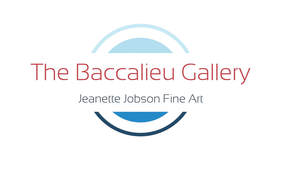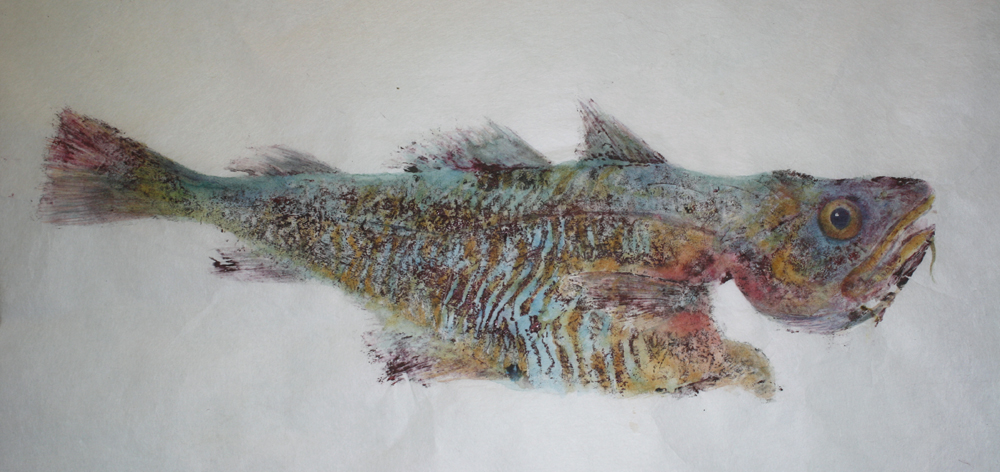the Gyotaku Project
Gyotaku literally translates as fish rubbing. Gyo = fish, taku = rubbing and is pronounced as gee-o- TAH-koo
Gyotaku is an Japanese technique of recording fish catches by inking the body of a fish, then pressing thin paper over the form to obtain a mirror image. In Japan gyotaku prints have even been used to determine the outcome of fishing competitions.
The oldest gyotaku was found in Japan, dating back to 1862. The original technique was first recorded in the late 1800s and may have its roots in China, but it wasn't until the 1950s that gyotaku made its way to North America. Lord Sakai of the Yamagata prefecture made a big catch in one night, and to preserve the memory, prints were made of large red sea bream. The gyotaku piece was commissioned by Lord Sakai, however the actual artist is unknown.
Today, gyotaku has become more an art form than a practical tool, and pieces range from the traditional print with the eye added, to elaborate colouring and backgrounds using mixed media. The gyotaku print at the top of this page is of an ocean perch, commonly known as red fish in Newfoundland and Labrador, due to the colouring of the fish.
Gyotaku is an Japanese technique of recording fish catches by inking the body of a fish, then pressing thin paper over the form to obtain a mirror image. In Japan gyotaku prints have even been used to determine the outcome of fishing competitions.
The oldest gyotaku was found in Japan, dating back to 1862. The original technique was first recorded in the late 1800s and may have its roots in China, but it wasn't until the 1950s that gyotaku made its way to North America. Lord Sakai of the Yamagata prefecture made a big catch in one night, and to preserve the memory, prints were made of large red sea bream. The gyotaku piece was commissioned by Lord Sakai, however the actual artist is unknown.
Today, gyotaku has become more an art form than a practical tool, and pieces range from the traditional print with the eye added, to elaborate colouring and backgrounds using mixed media. The gyotaku print at the top of this page is of an ocean perch, commonly known as red fish in Newfoundland and Labrador, due to the colouring of the fish.
In 2010 I embarked on a year long project to develop a body of work in the traditional Japanese technique of gyotaku or fish printing using fish found in the waters of Newfoundland and Labrador. In that time period I experimented with many different species of fish, Japanese and western papers as well as printmaking inks and watercolours to see what worked well and what no so well. Yes, there were successes and learning curves, frustrations and lots of satisfaction.
One of the main challenges of the project was simply finding fish! Accessing whole fish became an issue early on in the project, but over time I found sources, often in unlikely places. Replica fish of some common species were purchased to help out with the fish shortage and to enable offering the technique to others in places where raw fish was not allowed or participants unwilling to use it.
The Japanese papers and printmaking inks were ordered based on recommendations from experienced gyotaku artists and paper manufacturers. Trial and error played a role in finding the perfect paper to use. Over time I knew instinctively what paper would work best with what fish, just how much ink to use to achieve a good print and how receptive different papers were to the addition of colour after the print process.
Traditional gyotaku is a print of the fish with the eye created in ink or watercolour. I take the process a step or three further by additions of colour to the body of the fish. This provided another learning curve with Japanese papers whose varying weights and textures provided a different reaction to watercolour for each piece used. Slow became my mantra with lots of test pieces.
I had no first hand knowledge of wet or dry mounting of finished pieces and it was nerve wracking doing the first few pieces. Because Japanese paper is so thin it needs to be mounted onto another sheet of similar paper. It is sandwiched with rice or wheat paste. The paper is so fragile when wet and prone to wrinkling. I still hold my breath a little in fear each time I wet mount a piece that I’ve worked for hours on, hoping that the mounting process will work.
I discovered species that I knew nothing about such as ocean pout and lumpfish. I became less squeamish in handing and preparing fish for the print process. Preparation of the fish is a true lesson in anatomy and the most time consuming part of the gyotaku process. I even tried my hand at printing sculpins, which didn’t print particularly well as they have little scale pattern and many protuberances. The most unwieldy was a three foot salmon which was lovely to print from but having the size paper to practice on and create prints was challenging. It wasn’t something that could be tested on a scrap of paper.
The final piece of the project was a one day workshop to enable others to learn gyotaku . This workshop was held on April 16, 2011 at the Anna Templeton Centre in St. John’s To book a gyotaku workshop for your group, visit the Workshop page
The YouTube movie below provides a glimpse into some of the finished gyotaku pieces that I have completed.
I have also produced a 30 page book, The Gyotaku Project, that gives a visual and written overview of the challenges and the successes. This book is available for purchase online as an ebook only at the link below.
One of the main challenges of the project was simply finding fish! Accessing whole fish became an issue early on in the project, but over time I found sources, often in unlikely places. Replica fish of some common species were purchased to help out with the fish shortage and to enable offering the technique to others in places where raw fish was not allowed or participants unwilling to use it.
The Japanese papers and printmaking inks were ordered based on recommendations from experienced gyotaku artists and paper manufacturers. Trial and error played a role in finding the perfect paper to use. Over time I knew instinctively what paper would work best with what fish, just how much ink to use to achieve a good print and how receptive different papers were to the addition of colour after the print process.
Traditional gyotaku is a print of the fish with the eye created in ink or watercolour. I take the process a step or three further by additions of colour to the body of the fish. This provided another learning curve with Japanese papers whose varying weights and textures provided a different reaction to watercolour for each piece used. Slow became my mantra with lots of test pieces.
I had no first hand knowledge of wet or dry mounting of finished pieces and it was nerve wracking doing the first few pieces. Because Japanese paper is so thin it needs to be mounted onto another sheet of similar paper. It is sandwiched with rice or wheat paste. The paper is so fragile when wet and prone to wrinkling. I still hold my breath a little in fear each time I wet mount a piece that I’ve worked for hours on, hoping that the mounting process will work.
I discovered species that I knew nothing about such as ocean pout and lumpfish. I became less squeamish in handing and preparing fish for the print process. Preparation of the fish is a true lesson in anatomy and the most time consuming part of the gyotaku process. I even tried my hand at printing sculpins, which didn’t print particularly well as they have little scale pattern and many protuberances. The most unwieldy was a three foot salmon which was lovely to print from but having the size paper to practice on and create prints was challenging. It wasn’t something that could be tested on a scrap of paper.
The final piece of the project was a one day workshop to enable others to learn gyotaku . This workshop was held on April 16, 2011 at the Anna Templeton Centre in St. John’s To book a gyotaku workshop for your group, visit the Workshop page
The YouTube movie below provides a glimpse into some of the finished gyotaku pieces that I have completed.
I have also produced a 30 page book, The Gyotaku Project, that gives a visual and written overview of the challenges and the successes. This book is available for purchase online as an ebook only at the link below.
Click to set custom HTML
Purchase The gyotaku project ebook
Available originals
|
|
|
|
|


